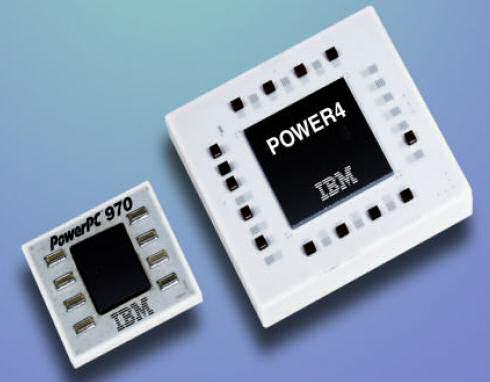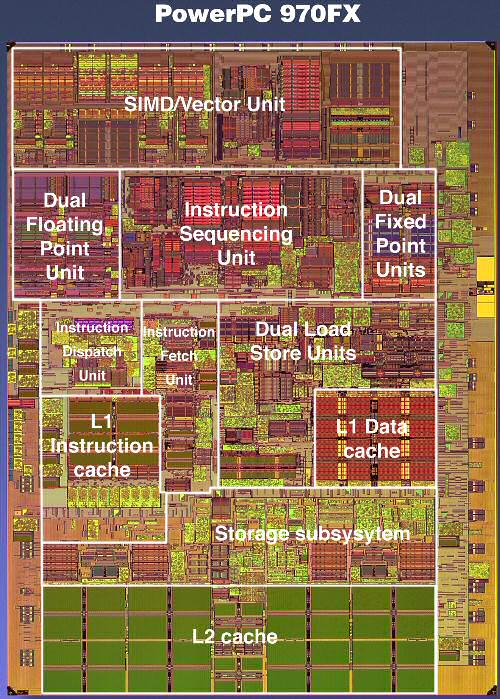No more mysteries: Apple's G5 versus x86, Mac OS X versus Linux
by Johan De Gelas on June 3, 2005 7:48 AM EST- Posted in
- Mac
IBM PowerPC 970FX: Superscalar monster
Meet the G5 processor, which is in fact IBM's PowerPC 970FX processor. The RISC ISA, which is quite complex and can hardly be called "Reduced" (The R of RISC), provides 32 architectural registers. Architectural registers are the registers that are visible to the programmer, mostly the compiler programmer. These are the registers that can be used to program the calculations in the binary (and assembler) code.
The 970FX is deeply pipelined, quite a bit deeper than the Athlon 64 or Opteron. While the Opteron has a 12 stage pipeline for integer calculations, the 970FX goes deeper and ends up with 16 stages. Floating point is handled through 21 stages, and the Opteron only needs 17. 21 stages might make you think that the 970FX is close to a Pentium 4 Northwood, but you should remember that the Pentium 4 also had 8 stages in front of the trace cache. The 20 stages were counted from the trace cache. So, the Pentium 4 has to do less work in those 20 stages than what the 970FX performs in those 16 or 21 stages. When it comes to branch prediction penalties, the 970FX penalty will be closer to the Pentium 4 (Northwood). But when it comes to frequency headroom, the 970FX should do - in theory - better than the Opteron, but does not come close to the "old" Pentium 4.

The 970FX works out of order and up to 200 instructions can be kept in flight, compared to 126 in the Pentium 4. The rate at which instructions are fetched will not limit the issue rate either. The PowerPC 970 FX fetches up to 8 instructions per cycle from the L1 and can decode at the same rate of 8 instructions per cycle. So, is the 970FX the ultimate out-of-order CPU?
While 200 instructions in flight are impressive, there is a catch. If there was no limitation except die size, CPUs would probably keep thousands of instructions in flight. However, the scheduler has to be able to pick out independent instructions (instructions that do not rely on the outcome of a previous one) out of those buffers. And searching and analysing the buffers takes time, and time is very limited at clock speeds of 2.5 GHz and more. Although it is true that the bigger the buffers, the better, the number of instructions that can be tracked and analysed per clock cycle is very limited. The buffer in front of the execution units is about 100 instructions big, still respectable compared to the Athlon 64's reorder buffer of 72 instructions, divided into 24 groups of 3 instructions.
The same grouping also happens on the 970FX or G5. But the grouping is a little coarser here, with 5 instructions in one group. This grouping makes reordering and tracking a little easier than when the scheduler would have to deal with 100 separate instructions.
The grouping is, at the same time, one of the biggest disadvantages. Yes, the Itanium also works with groups, but there the compilers should help the CPU with getting the slots filled. In the 970FX, the group must be assembled with pretty strict limitations, such as at one branch per group. Many other restrictions apply, but that is outside the scope of this article. Suffice it to say that it happens quite a lot that a few of the operations in the group consist of NOOP, no-operation, or useless "do nothing" instructions. Or that a group cannot be issued because some of the resources that one member of the group needs is not available ( registers, execution slots). You could say that the whole grouping thing makes the Superscalar monster less flexible.
Branch prediction is done by two different methods each with a gigantic 16K entry history table. A third "selector" keeps another 16K history to see which of the two methods has done the best job so far. Branch prediction seems to be a prime concern for the IBM designers.
Memory Subsystem
The caches are relatively small compared to the x86 competition. A 64 KB I-cache and 32 KB D-cache is relatively "normal", while the 512 KB L2-cache is a little small by today's standards. But, no complaints here. A real complaint can be lodged against the latency to the memory. Apple's own webpage talks about 135 ns access time to the RAM. Now, compare this to the 60 ns access time that the Opteron needs to access the RAM, and about 100-115 ns in the case of the Pentium 4 (with 875 chipset).A quick test with LM bench 2.04 confirms this:
| Host | OS | Mem read (MB/s) | Mem write (MB/s) | L2-cache latency (ns) | RAM Random Access (ns) |
| Xeon 3.06 GHz | Linux 2.4 | 1937 | 990 | 59.940 | 152.7 |
| G5 2.7 GHz | Darwin 8.1 | 2799 | 1575 | 49.190 | 303.4 |
| Xeon 3.6 GHz | Linux 2.6 | 3881 | 1669 | 78.380 | 153.4 |
| Opteron 850 | Linux 2.6 | 1920 | 1468 | 50.530 | 133.2 |
Memory latency is definitely a problem on the G5.
On the flipside of the coin is the excellent FSB bandwidth. The G5/Power PC 970FX 2.7 GHz has a 1.35 GHz FSB (Full Duplex), capable of sending 10.8 GB/s in each direction. Of course, the (half duplex) dual channel DDR400 bus can only use 6.4 GB/s at most. Still, all this bandwidth can be put to good use with up to 8 data prefetch streams.










116 Comments
View All Comments
michaelok - Saturday, June 4, 2005 - link
"with one benchmark showing that the PowerMac is just a mediocre PC while another shows it off as a supercomputer, the unchallenged king of the personal computer world."Well, things are a little different when you connect, say, 32768 processors together, i.e. you go from running MySQL to Teradata, so yes, the Power architecture seems to dominate, and the Virginia Tech supercomputer is still up there, at 7th.
http://www.top500.org/lists/plists.php?Y=2004&...
" The RISC ISA, which is quite complex and can hardly be called "Reduced" (The R of RISC), provides 32 architectural registers"
'Reduced Instruction Set' is misleading, it actually refers to a design philosophy of using *smaller, simpler* instructions, instead of a single complex instruction. This is to be compared with the Itanium for example, which Intel calls 'EPIC' (Explicit Parallel Instruction Computing), but it is essentially derived from VLIW (Very Long Instruction Word).
Anyway, nice article, certainly much more to discuss here, such as SMT (Simultaneous Multithreading), (when that is available for the Apple :), vs. Intel's Hyperthreading. We'll still be comparing Apples to Oranges but isn't that why everybody buys the Motor Trend articles, i.e. '68 Mustang vs. '68 GT?
psychodad - Saturday, June 4, 2005 - link
I agree. Recently I read a review which pitted macs against pcs using software blatantly optimized for macs. If you have ever used unoptimized software, you will know it. It is slow, often unstable and not at all usable, especially if you're after productivity.Viditor - Friday, June 3, 2005 - link
IntelUser2000 - "about the AMD TDP number, they never state that its max power, they say its maximum power achievable under most circumstances, its not absolute max power"Not true at all...AMD's datasheet clearly states that it's not only max power, but max theoretical power.
http://www.amd.com/us-en/assets/content_type/Downl...
trooper11 - Friday, June 3, 2005 - link
I think its hard enough comparing a G5 to PC systems. I dont belive there will ever be a 'fair' comparison that satisfies everyone on both sides. There are too few general programs to compare and people will always complain about using or not using optimized apps for either platform. many of the varibles are subjective and the benchmarks to be compared are so heavily debated without a clear answer.I think this was a good attempt, but I gave up trying to 'fairly' compare the two a long time ago. Anyhting that sheds a bit of light is a good thing, but i never expect an end to the contreversy, too many questions that cant be answered.
I would though love to see the addition of dual core amd chips since they are out there and would be serious competition, of course it would fly in server applications. hopefully the numbers for that could be added in a later article.
psychodad - Friday, June 3, 2005 - link
Fascinating. You run these tests using a compiler that Apple does not use (unless it is Yellow Dog) against software generally optimized for x86 architectures and you make conclusions. This makes your data tainted (actually biased) and your conclusions faulty. I would suggest that in fairness you make your tests more "real world" by using the software compiled by compilers that the rest of us nontechnical people use on a daily basis.smitty3268 - Friday, June 3, 2005 - link
Rosyna:Oh, I assumed he was using the Apple version of gcc. If not, then I see what you mean.
crimsonson - Friday, June 3, 2005 - link
This article may be moot by Mondayhttp://tinyurl.com/7ex4v
Garyclaus16 - Friday, June 3, 2005 - link
" Oh and the graph on page 5 doesnt display correctly in firefox. "AND you are using firefox for what reason?...you deserve to view pages incorrectly
Rosyna - Friday, June 3, 2005 - link
smitty3268, that's part of the problem. Almost no one uses GCC 3.3.3 (stock, from the main gcc branch) for Mac OS X development because it really sucks at optimizing for the PPC. On the other hand, OS X was compiled with the Apple shipped GCC 3.3/GCC 4.0.smitty3268 - Friday, June 3, 2005 - link
I think its fair to use the compilers most people are going to be using. That would be gcc on both platforms. As far as autovectorization in 4.0, don't expect very much from it. Obviously it will be better than 3.3, but the real work is being added now in 4.1.I'll join the other 50 posters who would have liked to see at least 1 page showing the G5's performance under linux compared to OSX. That and maybe a few more real world benchmarks. But your article was very informative and answered a lot of questions. It was frustrating that there really wasn't anything done like this before.